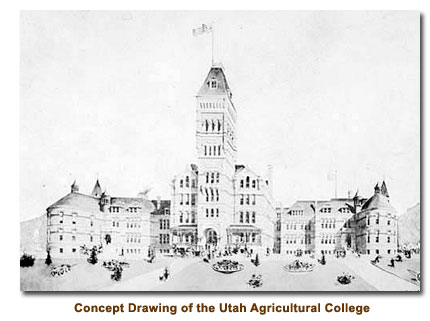Establishment of Utah Agricultural College
By an act of congress introduced by Hon. Justin S. Morrell of Vermont and passed July 2nd, 1862, 30,000 acres of public land was set apart for educational purposes to each state for each of its delegates in Congress. But as Utah had not then reached statehood, this land fund was not available. Later when Utah became a State in the Union, 90,000 acres of public land were given as an endowment for educational purposes in Utah.
Another act passed March 2nd, 1887, appropriated for the endowment of Experiment Stations for agricultural research, the annual sum of $15,000.00.
To avail itself of this later sum, which was open to the territories as well as to the states, the Utah Legislature, by law passed March 8th, 1888, founded the Agricultural College of Utah. This act gave the sum of $25,000.00 for the erection of buildings. Logan and Cache County supplemented it by a donation of one hundred acres of land and secured its location on the upper bench soil lying on the eastern outskirts of the city at an expenditure of $2,500.00 for the land. Very few colleges in America have been secured on such easy terms. Many of the prominent national colleges were located only after a heavy local donation. During the succeeding legislature, the south wing of the building was erected and at its completion, its first president was appointed in January 1890.
The Legislature then in session made its second donation of $48,000.00 to equip the College and to pay the salaries of its first faculty. During the session of the Legislature convened in 1890, Congress passed a third and supplementary Act to the Act of 1862, further endowing the college for the purpose of instruction. By this law $15,000.00 for the first year to be supplemented by and increase of $1,000.00 per year until the total sum of $25,000.00 annually, was given as a perpetual annuity. Under this law which had been somewhat delayed in its passage, $15,000.00 became due for the previous year, $16,000.00 for the year in which the law passed, and in the following July $17,000.00. Thus another $48,000.00 within the space of a few months came directly from the national treasury.
During the summer of 1890 a faculty of eight was organized for the purpose of instruction, and September 1st the doors were open for the reception of students. The College and its purposes were little known to the general public of Utah, but twenty-two students registered on the first day. As its benefits became better known, the enrollment rapidly increased until 139 students registered for the school year. The popularity of its courses of instruction was such that the institution was well advertised by its students in the surrounding states and territories.
After the close of the first school year the faculty was increased to fourteen and the second school year the enrollment reached 296. In the meanwhile it had so far developed its lines of instruction, that its excellence attracted attention and its patronage grew until in the third year of its scholastic work, between three and four hundred students were enrolled. During the season of1892, the faculty and Experiment Station workers were increased to nineteen, and the buildings were improved and finely furnished. The Territorial Legislature that convened January 1892, made a further appropriation to the College of $108,000.00. $43,000.00 of this sum was to supplement the Government appropriation for the purchase of apparatus and for the payment of its faculty. $65,000.00 was given for the erection of the north wing and a part of the center of the college building. After the completion of the main building with the wings, it was 343 feet long and about 100 feet in depth. At that time the college had made the most rapid progress of any similar national college in the country.
Although the territorial appropriation was not made until March 1890, the management at the Experiment Station prepared its one hundred acres of land for spring sowing and planting. The ground was covered with thick sagebrush and it was cleared and plats for experimental research were made and several acres sowed.
The faculty of the college in 1892 consisted of the following—
- Jeremiah W. Stanton, B. S., President, Professor of Agriculture.
- Everet S. Richmond, M. S. A., Professor of Horticulture, Entomology & Botany.
- William P. Cutter, B. S., Acting Professor of Physics and Mathematics.
- Addia L. Marlett, M. Sc., Professor of Domestic Economy.
- Jacob M. Scholl, B. M. E., Professor of Mechanical Engineering.
- John T. Caine, Jr., Principal of Preparatory Department.
- Alonzo A. Mills, B. Sc., Assistant Agriculturist.
- Sidney S. Twombly, M. S. D. V. S., Professor of Chemistry & Veterinary Surgeon.
- Joseph E. Shepard, Principal of Commercial Department.
- Mrs. Sarah W. Eddy, Instructor in Preparatory Department.
- Miss Lillie S. Thropp, Instructor of Music.
- James Dryden, Assistant Instructor in Commercia Department.
- E. J. McEvan, A. M., Professor of English and Modern Languages.
- E. Ada Little, Instructor in Music.
- Clare Kenyon, Librarian and Elocutionist.
- Geroge A. Crook, Instructor in Shop Work.
- Henry D. Styer, First Lieutenant U. S. A. Military Instructor.
- S. Fortier, Professor of Civil and Hydraulic Engineering.
